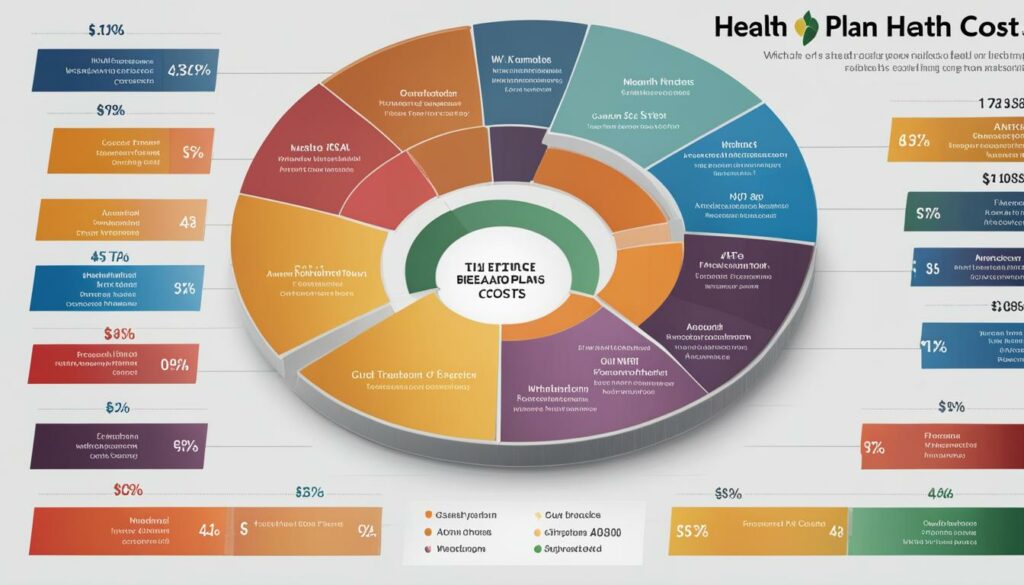Are you considering getting a health card but unsure about the costs involved? Understanding the price of a health card and how it fits into your budget is crucial when making this important decision. In this guide, we will break down the different factors that affect health card costs and help you choose the right plan for your needs.
Health insurance plans come in different categories, ranging from Bronze to Platinum, each representing how costs are split between you and your plan. Bronze plans require you to pay 40% of costs, while Platinum plans only require 10%. The right category for you depends on your budget and the level of coverage you need. Bronze plans are ideal for low-cost protection in worst-case scenarios, while Gold and Platinum plans offer more coverage for higher premiums.
Key Takeaways:
- Health insurance plans are categorized into Bronze, Silver, Gold, and Platinum.
- Each category determines how costs are split between you and your plan.
- Consider your budget and coverage needs when choosing a plan category.
- Bronze plans are low-cost options for worst-case scenarios.
- Gold and Platinum plans offer more coverage for higher premiums.
Which Category is Right For You?
When it comes to choosing a health plan, it’s important to consider which category is right for you. Each category – Bronze, Silver, Gold, and Platinum – offers different levels of cost-sharing and coverage. By understanding your budget, anticipated healthcare needs, and desired level of protection, you can make an informed decision that suits your individual circumstances.
Bronze plans have the lowest monthly premiums but higher costs when you need care. They are a good option if you want a low-cost way to protect yourself from serious sickness or injury. However, if you anticipate needing more routine care or have ongoing medical conditions, you may want to consider other categories.
Silver plans offer moderate monthly premiums and costs when you need care. They are a suitable choice if you qualify for extra savings or if you are willing to pay slightly higher premiums for more coverage of routine care.
Gold plans have higher monthly premiums, but lower costs when you receive care. If you are willing to pay more each month, a Gold plan can provide comprehensive coverage and help minimize out-of-pocket expenses.
Platinum plans have the highest monthly premiums, but they offer the lowest costs when you receive care. These plans are an excellent choice for individuals who use a lot of healthcare services and want the majority of their costs covered.
Ultimately, the right category for you depends on your unique needs and priorities. By carefully evaluating your budget and anticipated healthcare usage, you can choose the category that provides the best balance between cost and coverage.
Table: Health Plan Category Comparison
| Category | Monthly Premiums | Costs When You Need Care |
|---|---|---|
| Bronze | Lowest | Higher |
| Silver | Moderate | Moderate |
| Gold | Higher | Lower |
| Platinum | Highest | Lowest |
This table provides a quick comparison of the different health plan categories. It highlights the varying levels of monthly premiums and costs when you need care. By referring to this table, you can get a clearer understanding of the financial implications associated with each category and make an informed decision based on your specific circumstances.
How Health Plan Costs Are Split
Understanding how health plan costs are split is essential for selecting the right health insurance plan. Health plan costs are typically shared between the individual and the insurance plan through various methods such as deductibles, copayments, and coinsurance.
Deductibles: A deductible is the amount of money that an individual must pay out-of-pocket before the insurance coverage kicks in. It is important to note that deductibles vary depending on the health plan category. Higher deductible plans often have lower monthly premiums, but individuals may have to pay more upfront before their insurance coverage begins.
Copayments: Copayments are fixed amounts that individuals are responsible for paying for certain services. For example, a copayment for a doctor’s visit might be $30. Copayments can vary depending on the health plan and the specific service being provided.
Coinsurance: Coinsurance is the percentage of the total cost of covered services that individuals are responsible for paying. For instance, if an individual has a coinsurance of 20% for a hospital stay that costs $10,000, they would pay $2,000, while the insurance plan would cover the remaining $8,000. The percentage of coinsurance can vary based on the health plan category.
Understanding how health plan costs are divided can help individuals estimate their out-of-pocket expenses and make informed decisions when selecting a health insurance plan. It is important to carefully review the details of each plan to understand the specific costs associated with deductibles, copayments, and coinsurance.

Table: Health Plan Cost-Sharing Overview
| Health Plan Category | Deductibles | Copayments | Coinsurance |
|---|---|---|---|
| Bronze | Higher deductibles | Varies | 40% paid by individual, 60% covered by plan |
| Silver | Moderate deductibles | Varies | 30% paid by individual, 70% covered by plan |
| Gold | Lower deductibles | Varies | 20% paid by individual, 80% covered by plan |
| Platinum | Lowest deductibles | Varies | 10% paid by individual, 90% covered by plan |
The table above provides an overview of the cost-sharing details for different health plan categories. It is important to note that the specific deductibles, copayments, and coinsurance percentages may vary between insurance plans within each category. It is recommended to review the Summary of Benefits and Coverage (SBC) for each plan to get a more detailed understanding of the cost-sharing structure.
Using the Summary of Benefits and Coverage (SBC) to Compare Plans
The Summary of Benefits and Coverage (SBC) is a valuable tool for comparing different health insurance plans. This document provides an easy-to-understand summary of the costs, benefits, and coverage offered by each plan, allowing you to make an informed decision about which plan best meets your needs.
When reviewing an SBC, pay close attention to the information provided about deductibles, copayments, and coinsurance. These factors will directly impact the amount you will need to pay out-of-pocket for medical services. Look for any potential cost-sharing limits or maximum out-of-pocket expenses to understand the financial protection offered by each plan.
The SBC also includes examples of how a plan might cover specific health conditions, such as a pregnancy or a chronic illness. These examples can help you better understand how a plan would handle your specific healthcare needs. Additionally, the SBC provides a clear breakdown of what services are covered and any limitations or exclusions that may apply.
By carefully reviewing the SBC for each plan you are considering, you can compare the costs, benefits, and coverage options side by side. This will help you make an informed decision and choose the health insurance plan that best meets your needs and budget.

Table: Comparing Health Plan Features
| Health Plan Category | Deductibles | Copayments | Coinsurance | Coverage for Common Medical Events |
|---|---|---|---|---|
| Bronze | Higher | Varies | 40% | Lower |
| Silver | Moderate | Varies | 30% | Moderate |
| Gold | Lower | Varies | 20% | Higher |
| Platinum | Lower | Varies | 10% | Highest |
This table provides a comparison of key features for each health plan category. It clearly demonstrates how the deductible, copayments, coinsurance, and coverage for common medical events vary across categories. Use this table as a reference when analyzing the SBCs for different health plans.
The Different Types of Health Insurance Plans
When it comes to health insurance, there are various types of plans available to meet different needs. Understanding the options can help you make an informed decision about the best coverage for you and your family. Here are some of the different types of health insurance plans:
Employer-Sponsored Plans
Employer-sponsored plans are health insurance plans that are offered by employers to their employees. These plans can provide coverage for individuals and families and are often a convenient option because they are typically obtained through your workplace. Employer-sponsored plans can vary in terms of cost and coverage, so it’s important to carefully review the details of the plan options available to you.
Individual and Family Plans
Individual and family plans are health insurance plans that are purchased privately, either through a marketplace or directly from an insurance company. These plans are commonly chosen by individuals and families who are self-employed or do not have access to employer-sponsored coverage. Individual and family plans allow you to select a plan that aligns with your specific needs and offers a range of coverage options.
Medicare Plans
Medicare is a federal health insurance program primarily for individuals who are 65 years or older. It also covers certain younger individuals with disabilities. When you become eligible for Medicare, you can choose from different plan types, including Original Medicare (Part A and Part B), Medicare Advantage (Part C), and prescription drug coverage (Part D). Medicare plans are designed to provide comprehensive coverage for medical services and prescription drugs.
Short-Term Plans
Short-term plans, also known as temporary health insurance, are designed to provide coverage for a limited period of time. These plans are often used as a temporary solution when you experience a gap in coverage, such as during a job transition or while waiting for another health insurance plan to begin. Short-term plans typically offer basic coverage and are not required to comply with all of the Affordable Care Act’s regulations.
Dental Insurance and Vision Insurance
In addition to medical coverage, there are also separate insurance plans available specifically for dental care and vision care. Dental insurance plans provide coverage for routine dental services, such as cleanings, fillings, and extractions. Vision insurance plans cover services related to eye care, such as annual eye exams, prescription glasses, and contact lenses. These plans can be purchased as standalone coverage or as part of a comprehensive health insurance plan.
As you consider your options for health insurance, it’s important to carefully assess your needs and budget. Compare the different types of plans available to determine which one provides the coverage you require at a cost that fits within your financial means. Remember to review the terms and conditions of each plan, including deductibles, copayments, and network restrictions, to ensure that the plan aligns with your healthcare needs.
HMOs vs. PPOs: Understanding the Differences
When it comes to health insurance coverage, there are two common types to consider: Health Maintenance Organizations (HMOs) and Preferred Provider Organizations (PPOs). Understanding the differences between these two options is crucial in finding the right fit for your healthcare needs.
An HMO requires you to choose a primary care doctor who acts as the gatekeeper for your medical care. This means that you must go through your primary care doctor and obtain referrals for any specialized treatment or consultations. HMOs generally have lower premiums compared to PPOs, making them an attractive option for individuals on a tight budget. However, it’s important to note that HMOs often restrict you to a network of healthcare providers, limiting your choices.
On the other hand, PPOs offer more flexibility in terms of provider choice. With a PPO, you have the freedom to see any healthcare professional or specialist without requiring a referral from a primary care doctor. This allows for greater control over your healthcare decisions. However, PPOs typically come with higher premiums and costs compared to HMOs.
“Choosing between an HMO and a PPO depends on your personal preferences and healthcare needs. If you prefer having a primary care doctor who coordinates your care and are okay with a restricted network, an HMO could be a cost-effective choice. If you value the freedom to see any doctor you want without referrals, a PPO might be a better fit, despite the higher costs.”
Ultimately, the decision between an HMO and a PPO should be based on your individual circumstances and healthcare requirements. Consider factors such as your budget, preferred level of provider choice, and the importance of referrals in your decision-making process. By carefully weighing these factors, you can make an informed choice and select the health insurance coverage that best meets your needs.
Table: Comparing HMOs and PPOs
| Aspect | HMO | PPO |
|---|---|---|
| Primary Care Doctor | Required | Not required |
| Specialist Referrals | Required | Not required |
| Provider Network | Restricted | More choices |
| Premiums | Lower | Higher |
| Out-of-Network Coverage | Limited or no coverage | Partial coverage |
Table: A comparison highlighting the key differences between HMOs and PPOs.
Conclusion
As you navigate the world of health insurance, it’s crucial to have a clear understanding of how much a health card costs and the factors to consider when choosing the right plan. By evaluating your healthcare needs, budget, and available coverage options, you can make an informed decision that aligns with your priorities.
Remember to take advantage of resources such as this health insurance guide to enhance your knowledge and aid in your decision-making process. The guide provides valuable insights into the different health plan categories, cost-sharing methods, and the importance of reviewing the Summary of Benefits and Coverage (SBC).
Additionally, when you need personalized assistance and guidance, don’t hesitate to reach out to licensed insurance agents who can offer expert advice tailored to your specific needs. They can help you navigate the complexities of health insurance and provide you with the necessary resources to ensure you select the best plan for your well-being and peace of mind.
FAQ
What are the different categories of health insurance plans?
The different categories of health insurance plans are Bronze, Silver, Gold, and Platinum.
How are the costs split between me and my insurance plan?
The costs of a health plan are split through deductibles, copayments, and coinsurance.
What is the Summary of Benefits and Coverage (SBC)?
The SBC is a document that explains the costs, benefits, and coverage of a health plan in an easy-to-understand format.
What types of health insurance plans are available?
There are several types of health insurance plans available, including employer-sponsored plans, individual and family plans, Medicare plans, short-term plans, dental insurance, and vision insurance.
What is the difference between an HMO and a PPO?
HMOs require you to choose a primary care doctor and get referrals for specialists, while PPOs do not require a primary care doctor or referrals.
How can I choose the right health insurance plan?
To choose the right health insurance plan, consider factors such as your budget, anticipated healthcare needs, and coverage options available. Reviewing the SBC for each plan can help you understand the costs and coverage in detail.
Where can I find further assistance and guidance for selecting a health insurance plan?
There are resources available, such as licensed insurance agents, who can provide further assistance and guidance throughout the process of selecting a health insurance plan.





